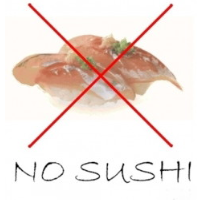Drought Zaps One-Fourth of California’s $5 Billion Rice Crop

Sushi eaters might be about to take a big hit.
“Virtually every piece of sushi made in America is made with California rice,” according to the USA Rice Federation, but California farmers are warning that one-quarter of this year’s $5 billion crop may be lost because of the ongoing drought.
“We anticipate about 420,000 acres of rice has been planted and will be harvested this fall, and that’s down about 25 percent from last year’s crop,” Mike Dewitt of Dewitt Farms told CBS Sacramento. “My dad’s been doing this for 40 years, and not even in the big drought of [1976-77] did he experience this.”
California has been growing rice since 1912 and harvests more of it than any other state, except Arkansas. The crop contributes $1.8 billion a year to the state’s economy and helps generate 25,000 jobs. California is the country’s number one agricultural state and rice is one of its top 10 crops.
Wildlife will miss the rice. More than 95% of the crop is grown within five miles of Sacramento, and is a food source for critters. For instance, the rice is nearly 60% of the food for 7 to 10 million wintering ducks and geese.
Farmers knew back in April that reduced water allocations would mean a smaller crop planted in June, but it’s not an experience they had been through before. Rice farmers usually have a lot of water compared to growers in the southern part of the state, even in dry years, profiting in its sale to others less fortunate.
There is an industry of rice mills, storage facilities, equipment providers and buyers who will be discomfited by the cutbacks. Nicole Van Vleck of Montna Farms told KPBS, “We have this wonderful system of customers that count on us each and every year and I don’t know that they’ll all be able to be serviced this year. Someone else will fill that void. You might not get the customer back,” she said.
Rice won’t be the only crop putting up rotten numbers this year. A U.S. Department of Agriculture (USDA) report in April forecast a 20% drop in rice production and a 35% drop in cotton (pdf), another big California crop.
California provides between one-third and one-half of the nation’s fruit and vegetables. But the crops the state’s farmers choose to grow changes from one year to the next. The New York Times pointed out there has been a shift in the state over the past decade to high-value nuts and berries crops—almonds, strawberries, raspberries and pistachios—which require more water than the declining crops of vegetables and melons—tomatoes, spinach, cantaloupes and asparagus.
California has shown great innovation in creating an agricultural empire in a state short of water, without effective water management policy, lacking any long-term farming strategy and periodically whipsawed by drought. It has tapped, and over tapped, available water supplies and maximized agricultural profits through suspect crop selection.
Now the state will get a chance to test its craftiness by balancing the needs of the agriculture industry, which uses at least 80% of the state’s water, and thirsty consumers who don’t want to stop flushing their toilets and watering their lawns. Those consumers also don’t want to give up their sushi.
–Ken Broder
To Learn More:
California’s Drought Wipes Out Nearly One Quarter of State’s $5 Billion Rice Crop (by Anjali Hemphill, CBS Sacramento)
California Drought Causing Billion-Dollar Losses in Rice Industry (by Jae C. Hong, Associated Press)
Rice Harvest May Drop 25% (by David Bitton, Marysville Appeal-Democrat)
California’s Thirsting Farmland (by Stephanie Strom, New York Times)
Drought Reduces Rice Crops, Raises Prices (by Amy Quinton, KPBS)
California Rice Facts (California Rice) (pdf)
- Top Stories
- Controversies
- Where is the Money Going?
- California and the Nation
- Appointments and Resignations
- Unusual News
- Latest News
- California Forbids U.S. Immigration Agents from Pretending to be Police
- California Lawmakers Urged to Strip “Self-Dealing” Tax Board of Its Duties
- Big Oil’s Grip on California
- Santa Cruz Police See Homeland Security Betrayal in Use of Gang Roundup as Cover for Immigration Raid
- Oil Companies Face Deadline to Stop Polluting California Groundwater





